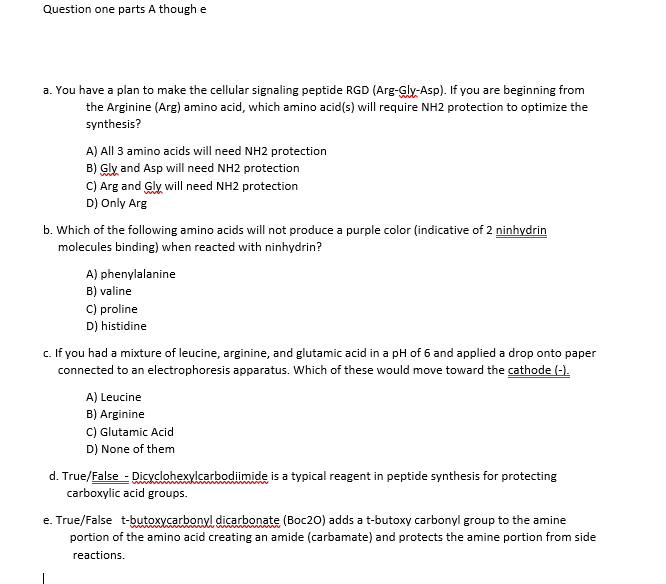a. You have a plan to make the cellular signaling peptide RGD (Arg-Gly-Asp). If you are beginning from the Arginine (Arg) amino acid, which amino acid(s) will require NH2 protection to optimize the synthesis? A) All 3 amino acids will need NH2 protection B) Gly and Asp will need NH2 protection C) Arg and Gly will need NH2 protection D) Only Arg b. Which of the following amino acids will not produce a purple color (indicative of 2 ninhydrin molecules binding) when reacted with ninhydrin? A) phenylalanine B) valine C) proline D) histidine c. f you had a mixture of leucine, arginine, and glutamic acid in a pH of 6 and applied a drop onto paper connected to an electrophoresis apparatus. Which of these would move toward the cathode (-). A) Leucine B) Arginine C) Glutamic Acid D) None of them d. True/False - Dicyclohexylcarbodiimide is a typical reagent in peptide synthesis for protecting carboxylic acid groups. e. True/False t-butoxycarbonyl dicarbonate (Boc20) adds a t-butoxy carbonyl group to the amine portion of the amino acid creating an amide (carbamate) and protects the amine portion from side reactions.
a. You have a plan to make the cellular signaling peptide RGD (Arg-Gly-Asp). If you are beginning from the Arginine (Arg) amino acid, which amino acid(s) will require NH2 protection to optimize the synthesis? A) All 3 amino acids will need NH2 protection B) Gly and Asp will need NH2 protection C) Arg and Gly will need NH2 protection D) Only Arg b. Which of the following amino acids will not produce a purple color (indicative of 2 ninhydrin molecules binding) when reacted with ninhydrin? A) phenylalanine B) valine C) proline D) histidine c. f you had a mixture of leucine, arginine, and glutamic acid in a pH of 6 and applied a drop onto paper connected to an electrophoresis apparatus. Which of these would move toward the cathode (-). A) Leucine B) Arginine C) Glutamic Acid D) None of them d. True/False - Dicyclohexylcarbodiimide is a typical reagent in peptide synthesis for protecting carboxylic acid groups. e. True/False t-butoxycarbonyl dicarbonate (Boc20) adds a t-butoxy carbonyl group to the amine portion of the amino acid creating an amide (carbamate) and protects the amine portion from side reactions.
Biochemistry
9th Edition
ISBN:9781305961135
Author:Mary K. Campbell, Shawn O. Farrell, Owen M. McDougal
Publisher:Mary K. Campbell, Shawn O. Farrell, Owen M. McDougal
Chapter3: Amino Acids And Peptides
Section: Chapter Questions
Problem 54RE: THOUGHT QUESTION Imagine we identify a gene that is directly responsible for the effects of...
Related questions
Question

Transcribed Image Text:Question one parts A though e
a. You have a plan to make the cellular signaling peptide RGD (Arg-Gly-Asp). If you are beginning from
the Arginine (Arg) amino acid, which amino acid(s) will require NH2 protection to optimize the
synthesis?
A) All 3 amino acids will need NH2 protection
B) Gly and Asp will need NH2 protection
C) Arg and Gly will need NH2 protection
D) Only Arg
b. Which of the following amino acids will not produce a purple color (indicative of 2 ninhydrin
molecules binding) when reacted with ninhydrin?
A) phenylalanine
B) valine
C) proline
D) histidine
c. If you had a mixture of leucine, arginine, and glutamic acid in a pH of 6 and applied a drop onto paper
connected to an electrophoresis apparatus. Which of these would move toward the cathode (-).
A) Leucine
B) Arginine
C) Glutamic Acid
D) None of them
d. True/False - Dicyclehexvlcarbodiimide is a typical reagent in peptide synthesis for protecting
carboxylic acid groups.
e. True/False t-butoxycarbonyl dicarbonate (Boc20) adds a t-butoxy carbonyl group to the amine
portion of the amino acid creating an amide (carbamate) and protects the amine portion from side
reactions.
Expert Solution
This question has been solved!
Explore an expertly crafted, step-by-step solution for a thorough understanding of key concepts.
This is a popular solution!
Trending now
This is a popular solution!
Step by step
Solved in 2 steps with 2 images

Recommended textbooks for you

Biochemistry
Biochemistry
ISBN:
9781305961135
Author:
Mary K. Campbell, Shawn O. Farrell, Owen M. McDougal
Publisher:
Cengage Learning

Biology 2e
Biology
ISBN:
9781947172517
Author:
Matthew Douglas, Jung Choi, Mary Ann Clark
Publisher:
OpenStax

Biochemistry
Biochemistry
ISBN:
9781305961135
Author:
Mary K. Campbell, Shawn O. Farrell, Owen M. McDougal
Publisher:
Cengage Learning

Biology 2e
Biology
ISBN:
9781947172517
Author:
Matthew Douglas, Jung Choi, Mary Ann Clark
Publisher:
OpenStax